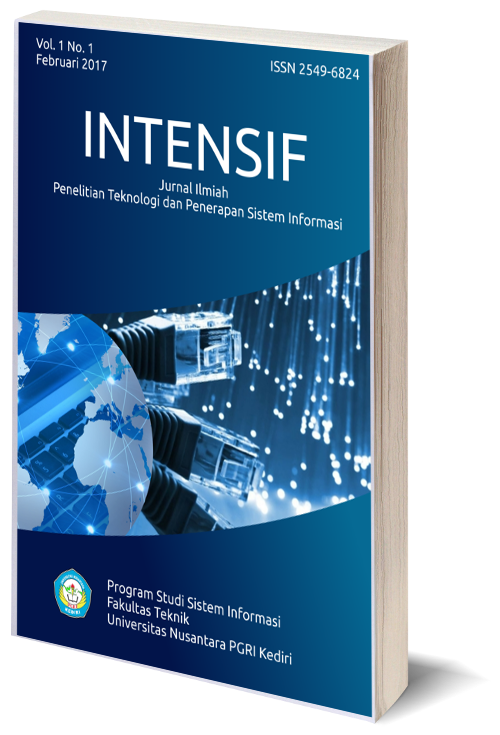Sistem Rekomendasi Destinasi Pariwisata Menggunakan Metode Hibrid Case Based Reasoning dan Location Based Service Sebagai Pemandu Wisatawan di Banyuwangi
DOI:
https://doi.org/10.29407/intensif.v1i1.540Keywords:
Rekomendasi wisata, hybrid, CBR, location basedAbstract
As one of the fastest growing tourist destinations, the number of tourist arrivals in Banyuwangi Regency shows a significant growth where in the range of 2010 - 2015 there is an increase of domestic tourists by 161% and abroad by 210%. The increase in tourist numbers is not a trouble-free process, especially with regard to visitor preferences that change over time. Tourist information and a variety of tourist interests often make tourists confused in determining the choice of any destination to visit. While Banyuwangi tourism information that is available in printed form or that can be accessed online still requires tourists to sort and choose their own in accordance with the interests and preferences so that tourists need any suggestions or recommendations. In the field of tourism, this recommendation may include objects to be visited, existing tourist events, travel schedules, travel routes, availability of infrastructure and so forth. The recommendation system proposed in this research uses a combination of (hybrid) case-based reasoning and location-based methods. The system is built in the form of android based mobile applications. Input from users to the system of travelers preferences include tourist types, tariff categories, modes of transportation, and tourism activities. These preferences together with user location based on GPS coordinates are further compared to the tourist object attributes stored on the system using the nearest neighbor similarity method. The output of the system in the form of recommendation of tourism object that has the highest similarity to the user preference. The results of this study are expected to assist tourists in choosing tourism objects in Banyuwangi according to their preferences or demand criteria.
Downloads
References
Widodo,S., dan Utomo, V.G. 2014.Rancang Bangun Aplikasi Travel Recommender Berbasis Wap Menggunakan Metode Fuzzy Model Tahani (Studi Kasus Di Kota Semarang). Jurnal Teknologi Informasi dan Komunikasi, ISSN : 2087 - 0868, Volume 5 Nomor 1 Maret 2014<br>
Petrevska, B., dan Koceski, S. 2012. Tourism Recommendation System: Empirical Investigation. Journal of tourism. [Issue 14]<br>
Pal, S.K., dan Shiu, S.C.K., 2004, Fondation of Soft Case-Based Reasoning, John Willey and Sons, Inc., New Jersey<br>
Shi, H., Xin, M., Dong, W., 2011, A Kind of Case Similarity Model Based on Case–Based Reasoning, International Conferences on Internet of Things, and Cyber, Physical and Social Computing IEEE, 453-457<br>
Nurdiansyah, Y., dan Hartati, S., 2014, Case-Based Reasoning untuk Pendukung Diagnosa Gangguan pada Anak Autis, Tesis, Prodi S2/S3 Ilmu Komputer JIKE FMIPA UGM, Yogyakarta<br>
Hastie, T., Tibshirani, R., dan Friedman, J., 2009, The Element of Statistical Learning : Data Mining, Inference, and Prediction, Springer Series in Statistic, 2, Springer-Verlag, Inc., New York<br>
Røine, P.C. 2011. Design and Evaluation of a Personalized Mobile Tourist System. Thesis. Norwegian University of Science and Technology Department of Computer and Information Science</p>
Downloads
Published
Issue
Section
License
Authors who publish with this journal agree to the following terms:
- Copyright on any article is retained by the author(s).
- The author grants the journal, the right of first publication with the work simultaneously licensed under a Creative Commons Attribution License that allows others to share the work with an acknowledgment of the work’s authorship and initial publication in this journal.
- Authors are able to enter into separate, additional contractual arrangements for the non-exclusive distribution of the journal’s published version of the work (e.g., post it to an institutional repository or publish it in a book), with an acknowledgment of its initial publication in this journal.
- Authors are permitted and encouraged to post their work online (e.g., in institutional repositories or on their website) prior to and during the submission process, as it can lead to productive exchanges, as well as earlier and greater citation of published work.
- The article and any associated published material is distributed under the Creative Commons Attribution-ShareAlike 4.0 International License












